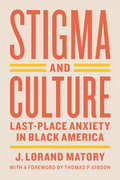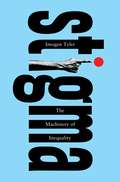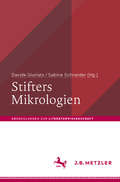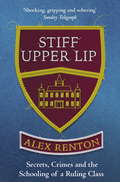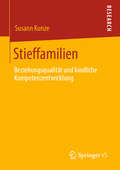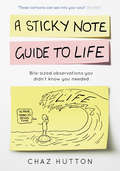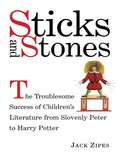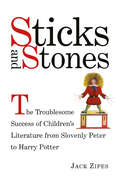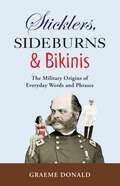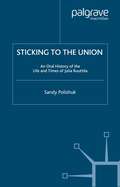- Table View
- List View
Stigma and Culture: Last-Place Anxiety in Black America (Lewis Henry Morgan Lecture Series)
by J. Lorand MatoryIn Stigma and Culture, J. Lorand Matory provocatively shows how ethnic identification in the United States—and around the globe—is a competitive and hierarchical process in which populations, especially of historically stigmatized races, seek status and income by dishonoring other stigmatized populations. And there is no better place to see this than among the African American elite in academia, where he explores the emergent ethnic identities of African and Caribbean immigrants and transmigrants, Gullah/Geechees, Louisiana Creoles, and even Native Americans of partly African ancestry. Matory describes the competitive process that hierarchically structures their self-definition as ethnic groups and the similar process by which middle-class African Americans seek distinction from their impoverished compatriots. Drawing on research at universities such as Howard, Harvard, and Duke and among their alumni networks, he details how university life—while facilitating individual upward mobility, touting human equality, and regaling cultural diversity—also perpetuates the cultural standards that historically justified the dominance of some groups over others. Combining his ethnographic findings with classic theoretical insights from Frantz Fanon, Fredrik Barth, Erving Goffman, Pierre Bourdieu and others—alongside stories from his own life in academia—Matory sketches the university as an institution that, particularly through the anthropological vocabulary of culture, encourages the stigmatized to stratify their own.
Stigma and Culture: Last-Place Anxiety in Black America (Lewis Henry Morgan Lecture Series)
by J. Lorand MatoryIn Stigma and Culture, J. Lorand Matory provocatively shows how ethnic identification in the United States—and around the globe—is a competitive and hierarchical process in which populations, especially of historically stigmatized races, seek status and income by dishonoring other stigmatized populations. And there is no better place to see this than among the African American elite in academia, where he explores the emergent ethnic identities of African and Caribbean immigrants and transmigrants, Gullah/Geechees, Louisiana Creoles, and even Native Americans of partly African ancestry. Matory describes the competitive process that hierarchically structures their self-definition as ethnic groups and the similar process by which middle-class African Americans seek distinction from their impoverished compatriots. Drawing on research at universities such as Howard, Harvard, and Duke and among their alumni networks, he details how university life—while facilitating individual upward mobility, touting human equality, and regaling cultural diversity—also perpetuates the cultural standards that historically justified the dominance of some groups over others. Combining his ethnographic findings with classic theoretical insights from Frantz Fanon, Fredrik Barth, Erving Goffman, Pierre Bourdieu and others—alongside stories from his own life in academia—Matory sketches the university as an institution that, particularly through the anthropological vocabulary of culture, encourages the stigmatized to stratify their own.
Stigma and Culture: Last-Place Anxiety in Black America (Lewis Henry Morgan Lecture Series)
by J. Lorand MatoryIn Stigma and Culture, J. Lorand Matory provocatively shows how ethnic identification in the United States—and around the globe—is a competitive and hierarchical process in which populations, especially of historically stigmatized races, seek status and income by dishonoring other stigmatized populations. And there is no better place to see this than among the African American elite in academia, where he explores the emergent ethnic identities of African and Caribbean immigrants and transmigrants, Gullah/Geechees, Louisiana Creoles, and even Native Americans of partly African ancestry. Matory describes the competitive process that hierarchically structures their self-definition as ethnic groups and the similar process by which middle-class African Americans seek distinction from their impoverished compatriots. Drawing on research at universities such as Howard, Harvard, and Duke and among their alumni networks, he details how university life—while facilitating individual upward mobility, touting human equality, and regaling cultural diversity—also perpetuates the cultural standards that historically justified the dominance of some groups over others. Combining his ethnographic findings with classic theoretical insights from Frantz Fanon, Fredrik Barth, Erving Goffman, Pierre Bourdieu and others—alongside stories from his own life in academia—Matory sketches the university as an institution that, particularly through the anthropological vocabulary of culture, encourages the stigmatized to stratify their own.
Stigma and Culture: Last-Place Anxiety in Black America (Lewis Henry Morgan Lecture Series)
by J. Lorand MatoryIn Stigma and Culture, J. Lorand Matory provocatively shows how ethnic identification in the United States—and around the globe—is a competitive and hierarchical process in which populations, especially of historically stigmatized races, seek status and income by dishonoring other stigmatized populations. And there is no better place to see this than among the African American elite in academia, where he explores the emergent ethnic identities of African and Caribbean immigrants and transmigrants, Gullah/Geechees, Louisiana Creoles, and even Native Americans of partly African ancestry. Matory describes the competitive process that hierarchically structures their self-definition as ethnic groups and the similar process by which middle-class African Americans seek distinction from their impoverished compatriots. Drawing on research at universities such as Howard, Harvard, and Duke and among their alumni networks, he details how university life—while facilitating individual upward mobility, touting human equality, and regaling cultural diversity—also perpetuates the cultural standards that historically justified the dominance of some groups over others. Combining his ethnographic findings with classic theoretical insights from Frantz Fanon, Fredrik Barth, Erving Goffman, Pierre Bourdieu and others—alongside stories from his own life in academia—Matory sketches the university as an institution that, particularly through the anthropological vocabulary of culture, encourages the stigmatized to stratify their own.
Stigma and Culture: Last-Place Anxiety in Black America (Lewis Henry Morgan Lecture Series)
by J. Lorand MatoryIn Stigma and Culture, J. Lorand Matory provocatively shows how ethnic identification in the United States—and around the globe—is a competitive and hierarchical process in which populations, especially of historically stigmatized races, seek status and income by dishonoring other stigmatized populations. And there is no better place to see this than among the African American elite in academia, where he explores the emergent ethnic identities of African and Caribbean immigrants and transmigrants, Gullah/Geechees, Louisiana Creoles, and even Native Americans of partly African ancestry. Matory describes the competitive process that hierarchically structures their self-definition as ethnic groups and the similar process by which middle-class African Americans seek distinction from their impoverished compatriots. Drawing on research at universities such as Howard, Harvard, and Duke and among their alumni networks, he details how university life—while facilitating individual upward mobility, touting human equality, and regaling cultural diversity—also perpetuates the cultural standards that historically justified the dominance of some groups over others. Combining his ethnographic findings with classic theoretical insights from Frantz Fanon, Fredrik Barth, Erving Goffman, Pierre Bourdieu and others—alongside stories from his own life in academia—Matory sketches the university as an institution that, particularly through the anthropological vocabulary of culture, encourages the stigmatized to stratify their own.
Stigma: The Machinery of Inequality
by Imogen TylerStigma is a corrosive social force by which individuals and communities throughout history have been systematically dehumanised, scapegoated and oppressed. From the literal stigmatizing (tattooing) of criminals in ancient Greece, to modern day discrimination against Muslims, refugees and the 'undeserving poor', stigma has long been a means of securing the interests of powerful elites.In this radical reconceptualisation Tyler precisely and passionately outlines the political function of stigma as an instrument of state coercion. Through an original social and economic reframing of the history of stigma, Tyler reveals stigma as a political practice, illuminating previously forgotten histories of resistance against stigmatization, boldly arguing that these histories provide invaluable insights for understanding the rise of authoritarian forms of government today.
Stigma: The Machinery of Inequality
by Imogen TylerStigma is a corrosive social force by which individuals and communities throughout history have been systematically dehumanised, scapegoated and oppressed. From the literal stigmatizing (tattooing) of criminals in ancient Greece, to modern day discrimination against Muslims, refugees and the 'undeserving poor', stigma has long been a means of securing the interests of powerful elites.In this radical reconceptualisation Tyler precisely and passionately outlines the political function of stigma as an instrument of state coercion. Through an original social and economic reframing of the history of stigma, Tyler reveals stigma as a political practice, illuminating previously forgotten histories of resistance against stigmatization, boldly arguing that these histories provide invaluable insights for understanding the rise of authoritarian forms of government today.
Stiftungen und soziale Innovationen: Strategien zur Lösung gesellschaftlicher Probleme (Soziale Investitionen)
by Steffen BethmannSteffen Bethmann untersucht die Effektivität und Wirkung privater Beiträge zum Gemeinwohl und die Entwicklung von Strategien sozialer Investoren. Er legt die organisationstheoretischen Grundlagen zur Erklärung von Stiftungshandeln und Innovationsfähigkeit von Stiftungen dar und untersucht mittels Fallstudien unter anderem ihre Entscheidungskriterien bei der Projektauswahl, ihre Förderstrategien und die Zusammenarbeit mit Partnern. Seine Ergebnisse zeigen, dass gerade die strukturelle Trägheit und Berechenbarkeit von Stiftungen diese zu verlässlichen Akteuren in sozialen Innovationsprozessen machen. Zugleich haben sie auch die Fähigkeit als Impulsgeber aufzutreten, wenn ihre eigenen Ressourcen und Strategien mit der Konfiguration eines Problemfelds übereinstimmen.
Stiftungen in Deutschland 3: Portraits und Themen
by Helmut K. Anheier Sarah Förster Janina Mangold Clemens StriebingDeutschland zeichnet sich durch ein stark gewachsenes und vielfältiges Stiftungswesen aus. Je nach Stiftungstyp üben Stiftungen unterschiedliche Rollen aus und leisten spezifische Beiträge, die jeweils andere Handlungsempfehlungen nahe legen. Der dritte Band der Studie zu „Stiftungen in Deutschland“ stellt diese Vielfalt der deutschen Stiftungslandschaft vor, behandelt typische Stärken und Schwächen verschiedener Stiftungstypen und geht auf ausgewählte Themen wie strategische Philanthropie, Advocacy, Vergleich Stiftungen in Ost- und Westdeutschland sowie Internationales ein. Im bisher größten Forschungsprojekt zum deutschen Stiftungswesen hat ein Forscherteam der Hertie School of Governance und des Centre for Social Investment der Universität Heidelberg um Helmut K. Anheier das deutsche Stiftungswesen systematisch und auf einer breiten empirischen Basis untersucht.
Stiftungen in Deutschland 2: Wirkungsfelder
by Helmut K. Anheier Sarah Förster Janina Mangold Clemens StriebingStiftungen bewegen sich mit ihren Zielen zwischen der Bewahrung von Tradition und Kultur, gesellschaftlichem Wandel und Fürsorge. Viele Stiftungen sehen sich als eigenständige innovative Kraft, andere als Förderer der Zivilgesellschaft oder als karitative Einrichtungen. Ersetzen oder ergänzen Stiftungen staatliches Handeln? Welche Rollen verfolgen sie und was ist ihr gesellschaftlicher Beitrag? Eine Forschungsgruppe der Hertie School of Governance und des Centre for Social Investment der Universität Heidelberg um Helmut K. Anheier hat in einem mehrjährigen Projekt das deutsche Stiftungswesen systematisch und auf Grundlage einer breiten empirischen Basis untersucht. Die Beiträge des Sammelbands bieten detaillierte Analysen von Stiftungen in den Bereichen Bildung und Erziehung, Wissenschaft und Forschung, Soziales, Kunst und Kultur sowie Advocacy und zeigen Handlungsempfehlungen auf.
Stiftungen in Deutschland 1: Eine Verortung
by Helmut K. Anheier Sarah Förster Janina Mangold Clemens StriebingIm bisher größten Forschungsprojekt zum deutschen Stiftungswesen wurde erstmals auf Grundlage einer umfangreichen Datenbasis eine Einschätzung der Rollen, Positionierungen und Beiträge deutscher Stiftungen vorgenommen. Der Band führt zunächst in den aktuellen Stand der Stiftungs- und Philanthropieforschung und das Vorgehen der Forschungsgruppe um Helmut K. Anheier ein. Es folgt ein umfassendes empirisches Bild des deutschen Stiftungswesens mit Fokus auf die Bereiche Bildung und Erziehung, Wissenschaft und Forschung, Soziales sowie Kunst und Kultur. Im Ergebnis zeichnet sich eine neue, vielfältige Landkarte des deutschen Stiftungswesens ab, die zivilgesellschaftliches Engagement, professionalisierte Philanthropie, wohlfahrtsstaatliche Dienstleistung und gemeinnützige Nischenangebote umfasst und jeweils unterschiedliche Handlungsempfehlungen impliziert.
Stifters Mikrologien (Abhandlungen zur Literaturwissenschaft)
by Davide Giuriato Sabine SchneiderDas Werk Adalbert Stifters zeichnet sich durch eine markante Aufmerksamkeit für das Kleine und vermeintlich Geringfügige aus, er gilt als Dichter des Details. Bereits die zeitgenössische Kritik hat sein „Diminutivtalent“ und Interesse für das „Kleinleben der Natur“ ins Visier genommen. So wie sich die Humanwissenschaften methodologisch auf die unwichtigen Nebensächlichkeiten, auf das Netz von geringfügigen Indizien und Symptomen zu stützen beginnen, so entdeckt dieser Sammelband Stifters Mikrologie als eine „unsichere Wissenschaft“, die sich gerade über unmerkliche Wahrnehmungen Aufschluss über größere Zusammenhänge erhofft. Der Zusammenhang von Literatur und Wissen, der hier aufgedeckt wird, bezieht sich auf Natur ebenso wie auf soziale Phänomene und beschreibt einen wesentlichen Aspekt der Poetologie Stifters.
Stiff Upper Lip: Secrets, Crimes and the Schooling of a Ruling Class
by Alex Renton'A brave and necessary book' GUARDIAN'Shocking, gripping and sobering' SUNDAY TELEGRAPHNo other society sends its young boys and girls away to school to prepare them for a role in the ruling class.Beating, bullying, fagging, cold baths, vile food and paedophile teachers are just some of the features of this elite education, and, while some children loved boarding school, others now admit to suffering life-altering psychological damage. Stiff Upper Lip exposes the hypocrisy, cronyism and conspiracy that are key to understanding the scandals over abuse and neglect in institutions all over the world.Award-winning investigative journalist Alex Renton went to three traditional boarding schools. Drawing on those experiences, and the vivid testimony of hundreds of former pupils, he has put together a compelling history, important to anyone wondering what shaped the people who run Britain in the twenty-first century.
Stieffamilien in Deutschland: Eltern und Kinder zwischen Normalität und Konflikt (DJI - Familien-Survey #10)
by Walter Bien Angela Hartl Markus TeubnerDas Buch beschreibt die Lebenssituation verheirateter und nichtehelicher Stieffamilien, es vergleicht mit der Lebenssituation von Kernfamilien und Alleinerziehenden und gibt einen Einblick in die Kommunikation zwischen den Mitgliedern einer Stieffamilie.
Stieffamilien: Beziehungsqualität und kindliche Kompetenzentwicklung
by Susann KunzeSusann Kunze untersucht den direkten und indirekten Einfluss der partnerschaftlichen Beziehungsqualität auf die Kompetenzen von Kindern, die in Stieffamilien aufwachsen. Mithilfe von statistischen Strukturgleichungsmodellen ermittelt sie aus den Daten des Beziehungs- und Familienpanels pairfam nicht nur verschiedene indirekte Einflüsse. Sie stellt auch in Gruppenvergleichen unterschiedliche Wirkmechanismen bei leiblichen und sozialen Eltern fest. Auf der Grundlage der Untersuchungsergebnisse und der hinzugezogenen Literatur entwickelt die Autorin einen pädagogischen Handlungsleitfaden für Stieffamilien.
Sticks and Stones: The Troublesome Success of Children's Literature from Slovenly Peter to Harry Potter
by Jack ZipesFirst Published in 2002. Routledge is an imprint of Taylor & Francis, an informa company.
Sticks and Stones: The Troublesome Success of Children's Literature from Slovenly Peter to Harry Potter
by Jack ZipesFirst Published in 2002. Routledge is an imprint of Taylor & Francis, an informa company.
Sticklers, Sideburns and Bikinis: The military origins of everyday words and phrases
by Graeme Donald Andrew Wiest William ShepherdDid you know they started 'hearing through the grapevine' during the American Civil War, that 'ghettos' originated in Venice or that 'deadline' has a very sinister origin? Jam-packed with many amazing facts, Fighting Talk is a fascinating trip through the words and phrases that came to us from the military but nowadays are used by soldier and civilian alike. The sources of many are surprising and their original use is often far removed from that of today. From 'duds' to 'freelancers' and 'morris dancing' to 'bikini' this enthralling book describes the military origins of words and phrases that we use on a daily basis.
Sticklers, Sideburns and Bikinis: The military origins of everyday words and phrases
by Graeme Donald Andrew Wiest William ShepherdDid you know they started 'hearing through the grapevine' during the American Civil War, that 'ghettos' originated in Venice or that 'deadline' has a very sinister origin? Jam-packed with many amazing facts, Fighting Talk is a fascinating trip through the words and phrases that came to us from the military but nowadays are used by soldier and civilian alike. The sources of many are surprising and their original use is often far removed from that of today. From 'duds' to 'freelancers' and 'morris dancing' to 'bikini' this enthralling book describes the military origins of words and phrases that we use on a daily basis.
Sticking to the Union: An Oral History of the Life and Times of Julia Ruuttila (Palgrave Studies in Oral History)
by S. PolishukSticking to the Union relates the vibrant life of Julia Ruuttila (1907-1991), a political radical and labor journalist in the Pacific Northwest. Ruuttila's life of activism provides a much-needed woman's voice in the history of labor and social activism in the twentieth century. Ruuttila worked for civil liberties, civil rights, and peace organizations throughout her life, supporting striking workers, taking part in lunch-counter protests against businesses that discriminated against African Americans, and demonstrating against the Vietnam War. Polishuk provides insightful historical context for Ruuttila's own lively words. A unique and important perspective on American struggles of the twentieth century emerges in this engaging story of an irrepressible, hard-nosed woman.
Sticker (Object Lessons)
by Henry HokeObject Lessons is a series of short, beautifully designed books about the hidden lives of ordinary things.Stickers adorn our first memories, dot our notebooks and our walls, are stuck annoyingly on fruit, and accompany us into adulthood to announce our beliefs from car bumpers. They hold surprising power in their ability to define and provoke, and hold a strange steadfast presence in our age of fading physical media. Henry Hoke employs a constellation of stickers to explore queer boyhood, parental disability, and ancestral violence. A memoir in 20 stickers, Sticker is set against the backdrop of the encroaching neo-fascist presence in Hoke's hometown of Charlottesville, Virginia, which results in the fatal terrorist attack of August 12th and its national aftermath. Object Lessons is published in partnership with an essay series in The Atlantic.
Sticker (Object Lessons)
by Henry HokeObject Lessons is a series of short, beautifully designed books about the hidden lives of ordinary things.Stickers adorn our first memories, dot our notebooks and our walls, are stuck annoyingly on fruit, and accompany us into adulthood to announce our beliefs from car bumpers. They hold surprising power in their ability to define and provoke, and hold a strange steadfast presence in our age of fading physical media. Henry Hoke employs a constellation of stickers to explore queer boyhood, parental disability, and ancestral violence. A memoir in 20 stickers, Sticker is set against the backdrop of the encroaching neo-fascist presence in Hoke's hometown of Charlottesville, Virginia, which results in the fatal terrorist attack of August 12th and its national aftermath. Object Lessons is published in partnership with an essay series in The Atlantic.
Stichworte zur Zeit: Ein Glossar (X-Texte zu Kultur und Gesellschaft)
by Heinrich-Böll-StiftungDie Frage »Wie wollen wir in Zukunft leben?« ist in aller Munde. Aber in welcher Welt leben wir eigentlich jetzt gerade? So banal es klingt: Es braucht Abstand, um das eigene Jetzt klarer sehen zu können. Gerade in Krisenzeiten kommt es darauf an, besser zu verstehen, was vor sich geht. Deshalb wiederholt die Heinrich-Böll-Stiftung - 40 Jahre nach den »Stichworten zur geistigen Situation der Zeit« - das Experiment und befragt Intellektuelle zu zentralen gesellschafts- und kulturdiagnostischen Stichworten unserer Zeit. Und was im Einzelnen assoziativ ist, wirft als Ganzes Licht auf das Unbekannte und Übersehene unserer Gesellschaft. Von A bis Z mit diesem Buch auf der Höhe der Zeit.
Stichwort: Zeitschrift für Erziehungswissenschaft
by Ingrid Gogolin Harm Kuper Heinz-Hermann Krüger Jürgen BaumertDer vorliegende Band enthält die besten Stichwortbeiträge der „Zeitschrift für Erziehungswissenschaft (ZfE)“ aus den vergangenen fünfzehn Jahren und gibt damit einen exzellenten Überblick zu relevanten Forschungsgebieten und Schwerpunkten dieser Zeit. Darin enthalten sind theoretische und methodologische erziehungswissenschaftliche Diskurse sowie Abhandlungen über den Wandel von pädagogischer Lernkultur, Institutionen und Professionen.
